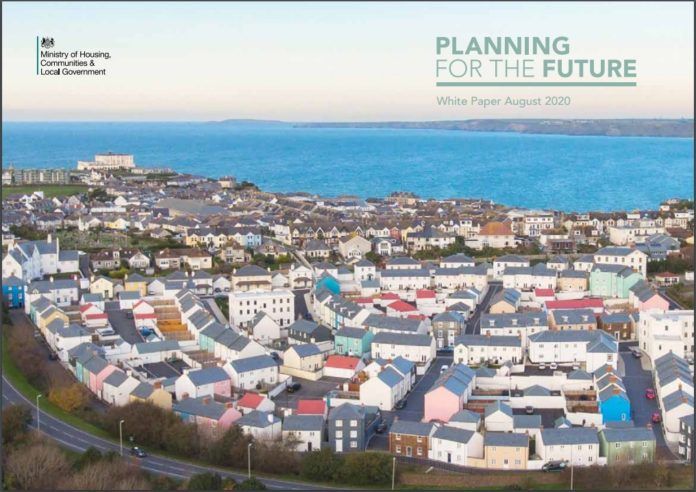
An overhaul of the country’s outdated planning system will be a “major boost” to small and medium-sized (SME) builders.
The government wants smaller housing developers and contractors, currently cut off by the planning process, to be “key players in getting the country building on the scale needed to drive our economic recovery.”
SME builders have seen their share of the new housing development market drastically drop from 40% 30 years ago to just 12% today. The complex planning system is seen as a major hurdle for smaller businesses.
Housing Secretary Robert Jenrick has unveiled plans for a major overhaul of the system with his ‘Planning for the Future White Paper’, published today [6 August]. He said: “Our complex planning system has been a barrier to building the homes people need; it takes seven years to agree local housing plans and five years just to get a spade in the ground.
“We will cut red tape, but not standards, placing a higher regard on quality, design and the environment than ever before.
“Planning decisions will be simple and transparent, with local democracy at the heart of the process. As we face the economic effects of the pandemic, now is the time for decisive action and a clear plan for jobs and growth.
“Our reforms will create thousands of jobs, lessen the dominance of big builders in the system, providing a major boost for small building companies across the country.”
A new and simpler system of developer contributions will also ensure private firms play their part in funding the new infrastructure and affordable homes that should accompany new building.
Section 106 agreements and the Community Infrastructure Levy will be replaced with a new Infrastructure Levy that will be a fixed proportion of the value of the development, above a set threshold, helping to deliver more affordable housing.
The reforms will mean:
- Local communities will be consulted from the very beginning of the planning process. By harnessing the latest technology through online maps and data, the whole system will be made more accessible
- Valued green spaces will be protected for future generations by allowing for more building on brownfield land and all new streets to be tree lined
- Much-needed homes will be built quicker by ensuring local housing plans are developed and agreed in 30 months – down from the current seven years
- Every area to have a local plan in place – currently only 50% of local areas has a plan to build more homes
- The planning process to be overhauled and replaced with a clearer, rules-based system. Currently around a third of planning cases that go to appeal are overturned at appeal
- A new simpler national levy to replace the current system of developer contributions, which often causes delay
- The creation of a fast-track system for beautiful buildings and establishing local design guidance for developers to build and preserve beautiful communities
- All new homes to be ‘zero carbon ready’, with no new homes delivered under the new system needed to be retrofitted as we achieve our commitment to net zero carbon emissions by 2050.
Industry reaction to the planning system reform in England
James Thomson, chief executive officer of Gleeson Homes, said: “We strongly support the reform of our historic planning system, to bring it up to speed and ensure it is fit for purpose for the modern-day.
“In particular, we welcome initiatives to make it more transparent, speed up planning where appropriate and has a presumption towards development rather than against.
“Not only will these reforms go some way to supporting local SME housebuilders and their supply chains, but they will also help to ‘level-up’ the country through increased infrastructure investment, bringing jobs and homes to the north.”
Brian Berry, chief executive officer of the Federation of Master Builders, added: “Local, small builders are ready and waiting to play their part in delivering the homes, jobs, and growth we need if we are to ‘build, build, build’ our way to recovery.
“But the increasing complexities and costs of the planning system in England have held them back. Alongside struggles to access affordable land, 64% of developing small builders cite the planning system as the biggest barrier they face.”
Brian continued: “We need a simpler and more responsive planning system, but I am clear that this shouldn’t compromise the quality of the homes that are built. Master builders compete on quality, not on price, and have an important role to play in a more diverse housing market.
“We must also ensure local planning authorities are supported to respond to these changes, so that any shake-up doesn’t lead to further short-term delays in applications. If we get this right, making it easier for SME housebuilders to play a role will help support jobs, provide training opportunities for apprentices, and lead to higher quality, green homes that are fit for the future.”
John Alker, director of policy and places at UKGBC, said: “Planning is part of a wider system that is failing to deliver both the quality and quantity of homes needed to tackle the environmental and social challenges we face.
“High-quality, sustainable design is key to securing support from communities, and this is more likely to be achieved when communities can contribute meaningfully to the design process. We therefore welcome the ambition to simplify the system and harness modern technology, as this will help both improve accessibility and provide much-needed certainty. However, the planning process must maintain the support and constructive involvement of local communities if it is to effectively deliver places that work for everyone.
“To help tackle both the climate and ecological crises, the plans must – crucially – form part of a coherent, long-term commitment by the government to environmental protection; one that gives developers clarity around low carbon, nature friendly investment. We welcome the aspiration that new homes will not need costly retrofitting, but if this is to be achieved we need to see a significant strengthening of energy efficiency standards in 2020 and 2025.”
To view the full consultation document click here.



